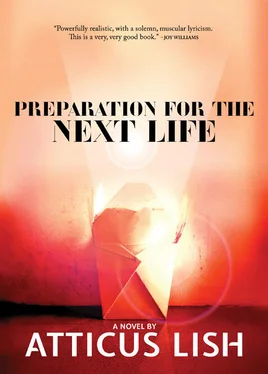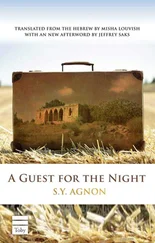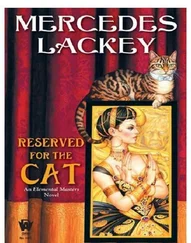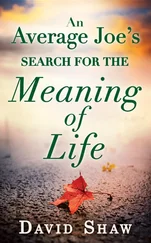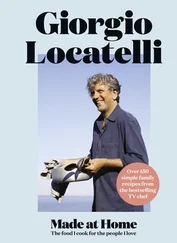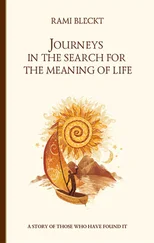Her sandals broke when she crossed a street with a high curb. Utopia Parkway. She couldn’t put them back together, so she tried to tie them to her feet another way — if only she had some string — but she could not. She tried to walk holding the thong between her toes, but it made it harder. She threw them in the street and walked on without them, curling her feet to keep the blisters off the pavement. The sidewalk was going to take her skin off. She would need medical attention. Her face was drawn. The edges of her feet were ragged and black. She looked at her feet and saw them suppurating. She came to a place where another street began: it flowed off of Northern Boulevard at an angle like a river, and it was Sanford Avenue — among decaying buildings, a funeral home with Korean writing, park benches, small trees, broken glass, and the parked cars like rocks on the riverbank. A furlong ahead of her the railroad tracks crossed the boulevard above the newsstands and flower stands. The graffiti on the metal said DEN RIP.
You’ve made it, she said and walked on not concerned by the pain. She looked for a hawk in the sky, an airplane perhaps, and saw pigeons. They were roosting under the trestles when she got there. She walked over white guano on her bleeding feet and it felt cool and wet. Now she had reached the gray sky that she had seen. It was warm and it would rain. On a board, someone had written: We Design Funeral Flowers. The Food Mart sold High Grade Cigars. Steve’s Coffee Shop. Fratelli’s Pizzeria. The 7&7 Deli Supermarket. We Accept WIC Checks. People were sleeping in the apartments up above with the windows open in squared-off brick buildings, pigeons on the ripped awnings. Beer Soda Lotto. Milk Barn Farms. Dairy Deli Grocery. Phone Cards. Metro Cards. A sun-faded ad for Boars Head meats. Adult males playing arcade games inside by the racks of potato chips. The New Asia Restaurant, here since 1989, the year of Tiananmen. Landscaping trucks. A run of boarded-up, burned-out storefronts. The notice said Victor Han Architects. The graffiti on the boards spelled Blunts. The T was devil’s horns. Die 666. Leiser’s Liquors. A sweatshirt tied around a broken parking meter. CSNR. Romer. Big Dick Fuck All Day. MS-X3. On the boards, the work order said construction by the Hua Fong Construction Corp. Feeney’s Tavern: two green turtles and a little green door, number 2401.
She went down Sanford Avenue past an abandoned house sealed by the marshal, by a notice, and possibly used anyway, the siding covered in soot and graffiti too, the backyard teeming with weeds. Mexicans waited for the bus. Between the four-story ghetto apartment buildings was a sea of weeds, tall grass, tires, road cones, a piece of heavy construction equipment, the houses at angles to each other, everything coming apart. Next door there were Mexican men with engines in the yard fixing the door of a beat-up silver-gold Impala. There was the LIRR. The graffiti on the rocks said GLCS. Pocos Pero Locos. A heart and Brazalhax y Soldado.
On the curb, she saw the strewn trash and the camouflage gear. There was yellow crime scene tape, a long strand of it stretched out in the driveway. She recognized some of her own clothes mixed with his. She made her way to the Murphy’s door and knocked. It was a city morning. You could hear both birds and cars. The train from Port Washington roared by through the trees across the avenue while she waited. She tucked her hair back and prepared to speak English.
The daughter came to the door, red-eyed. Help you?
Zou Lei tried to ask about Skinner.
And who was he to you? the daughter asked.
And you are?
Yeah, excuse me, and can I get your information in case the cops wanna talk to you?
Zou Who?
Okay thank you very much.
I’ll give them a description of you.
What about Skinner? You mean the piece of shit that lived here? I don’t know anything about him.
SHE DISCOVERED A GREATER desert than any she had previously known. It must have been that she was a great explorer. All of this was barren territory of the most forbidding kind. Mineral formations. No drinkable water. It would probably take more than one lifetime to cross it, she estimated. More time than she would have anyway. Like a traveler in space, she thought. But she had entered it, so she kept going across it in the nomadic way that was natural to her. If she expected to see anything, it was the graves of other migrants, their bodies half interred among the shorn-off tree stumps. The land was so vast she had no hope of seeing anyone she knew, neither mother nor father. The figures she saw were too small to distinguish. No one called out, Daughter I remember you. Where are you going? Stay with us and eat.
Not in this wasteland.
She got off a Greyhound bus in a place where the sunshine forced your eyes shut. She put her baseball cap on — the faded navy cotton was hot — to give her eyes enough shade to see where she was going. She walked among Mexicans in jeans and straw hats, women with wide waists and big bosoms and eyes made up like Cleopatra of Egypt, carrying their bags of clothes, children’s toys, rice. They climbed into the cars of sometimes ominous family members who came to meet them in the desert.
She had come, this time, by way of Queens, where she had stepped over the police tape and tried to retrieve his blanket or anything else of theirs out of the trash that could be salvaged. Money had been the last thing on her mind. She had been thinking only of holding onto him somehow. But this was how she found her Asics, and in her Asics she found his bank card, which she discovered still tucked inside the right sneaker, where she felt it with her torn-up foot when she put the sneaker on.
His PIN was something she found she could recall. After she withdrew two hundred dollars, she bought Singapore fried noodles and took a livery cab to the emergency room and sat there eating noodles and watching reality TV until they called out the fake name she had given them and a nurse examined her feet.
This is scary. How’d you do this?
Zou Lei left the hospital a few hours later with her feet bandaged and a blister pack of antibiotics and took another livery cab back to Cromellin Street.
Over the next ten days, wearing her hat down low, she went back to the ATM on crutches and kept withdrawing the daily maximum until she had all Skinner’s savings.
When her feet were healed and she could walk without crutches, she took her woven plastic bag, left her key with another of Har’s tenants, and headed to the Port Authority, where she bought a bus ticket to Phoenix, Arizona.
In Phoenix, she worked at a Chinese fast food restaurant in a one-floor strip mall. The building exteriors were fashioned of a concrete shell coating sprayed over Styrofoam, which was used to sculpt archways and other Southwestern architectural motifs. The stucco was painted an adobe dried-mud color. It was an efficient, lightweight, if not necessarily eye-pleasing, building style, with the unintended consequence that you could put your foot through any building you wanted to.
She almost tried to see if she could throw her manager through the stucco when he fired her for submitting a falsified social security number. It was the first time in her experience that she had worked for a white American boss at a Chinese restaurant. His remarks about immigrants, whom he called You People, had been exasperating to her. Also she felt he was far too proud of himself for having detected her crime by means of E-Verify, his favorite new tool. But what nearly made her violent was when he threatened to call Homeland on her.
You do that and I’ll make trouble for you. I know people you don’t want to mess with. Put me in jail? I’ll put you in the ground. Try that for size.
Читать дальше
